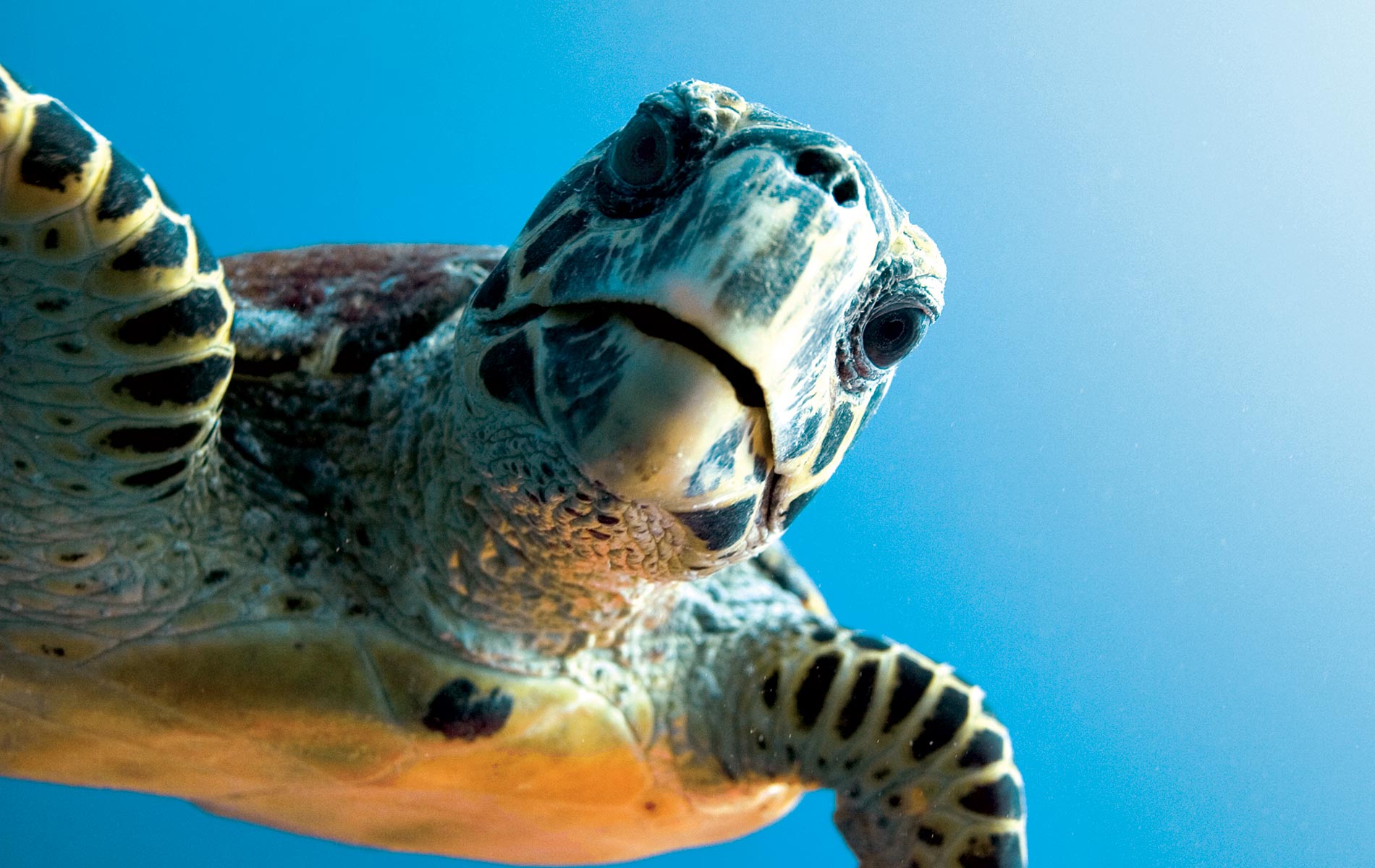
vie-magazine-sea-turtles
Casting a New Light on Sea Turtles
By Sallie Boyles
Evolving over 120 million years, sea turtles, now endangered, have uniquely adapted to the ever-changing planet. As a result, they have carved a highly specialized niche within an ecosystem that depends on their survival as much as the ancient reptiles have come to rely upon their surroundings. For many reasons, a primary threat to that essential natural balance is artificial nighttime lighting along the beaches. Arix Zalace, a lifelong resident of Northwest Florida, invented a flashlight filtering system as a solution that shows brilliance in its simplicity.
A little background about the sea turtle’s life will help to shed some light on the merit of Zalace’s innovation.
The most common among the five species of sea turtles inhabiting Florida’s waters is the loggerhead. The turtles, like all reptiles, are air-breathing, adeptly dive and swim with the help of their streamlined bodies and powerful, paddle-like flippers. Navigating overland is cumbersome, so the male rarely ambles ashore. Nevertheless, the female, upon reaching maturity, returns to land every other year to lay her eggs.
If conditions are right, she will nest multiple times during a single season. Astonishingly, a sea turtle will consistently lay her eggs within one hundred yards of the original nesting place from which she hatched.
How a female sea turtle so precisely returns again and again to the same spot on the beach is mostly a mystery, but scientists believe that location identifiers—such as electromagnetic fields, smell, low-frequency sounds like surf noise, and characteristics of seasonal offshore currents—are imprinted during the hatchling’s initial journey from dune to sea. Therefore, no one should “help” a baby turtle reach the water by carrying it from its nest.
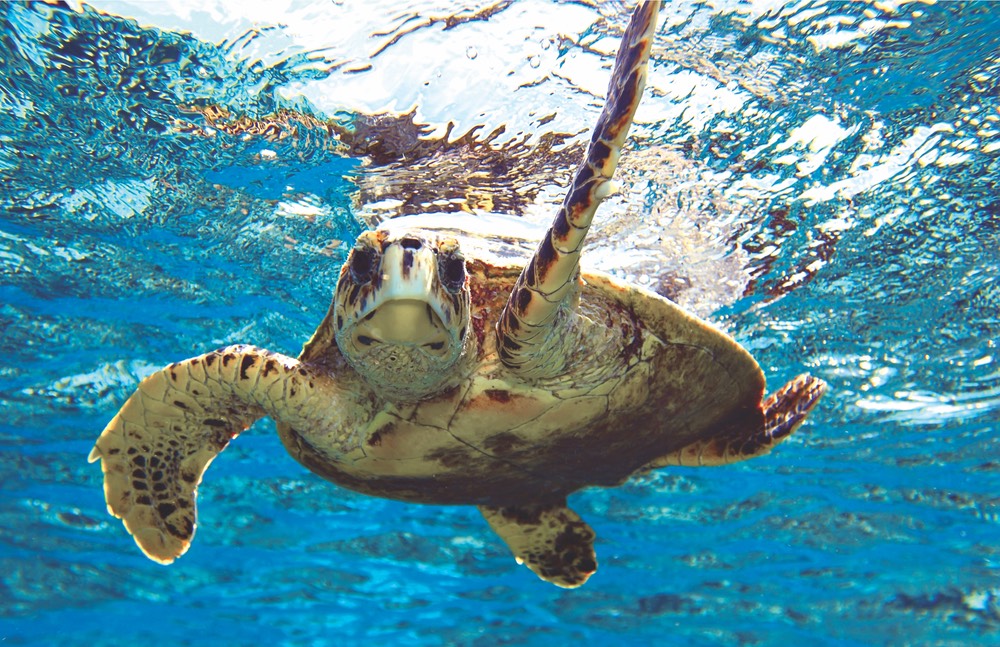
With the moon over the water, the cycle begins as the pregnant female swims along the coastline in search of the dark shore. If artificial lighting confuses her, she will, in fact, abandon her nesting attempt. From the start, a dark beach is essential.
Leaving a trail in the sand resembling mini tractor tracks, she drags herself to the dune line. There, she spins to dig a crater with her hind fins. When her nest is ready, she goes into a vulnerable trance while depositing her eggs. The number of eggs, the size of ping-pong balls, will range from 80 to 120. Covering the eggs in the warm sand is her final obligation to them.
The incubation period in South Walton is approximately sixty-two days. Rippling movements in the sand, referred to as a “boil” (as if a pot is about to boil), are the first sign of hatchling activity. Ideally, most eggs will hatch in the evening, when the darkness of night makes them less susceptible to prey or dehydration. At night, instinct draws the hatchlings toward the twinkling play of moonlight on the water. Making a beeline to the ocean is vital to their survival. By staying on course, hatchlings best avoid danger, such as night-patrolling ghost crabs.
[double_column_left][/double_column_left] [double_column_right]With the moon over the water, the cycle begins as the pregnant female swims along the coastline in search of the dark shore. If artificial lighting confuses her, she will, in fact, abandon her nesting attempt. From the start, a dark beach is essential.
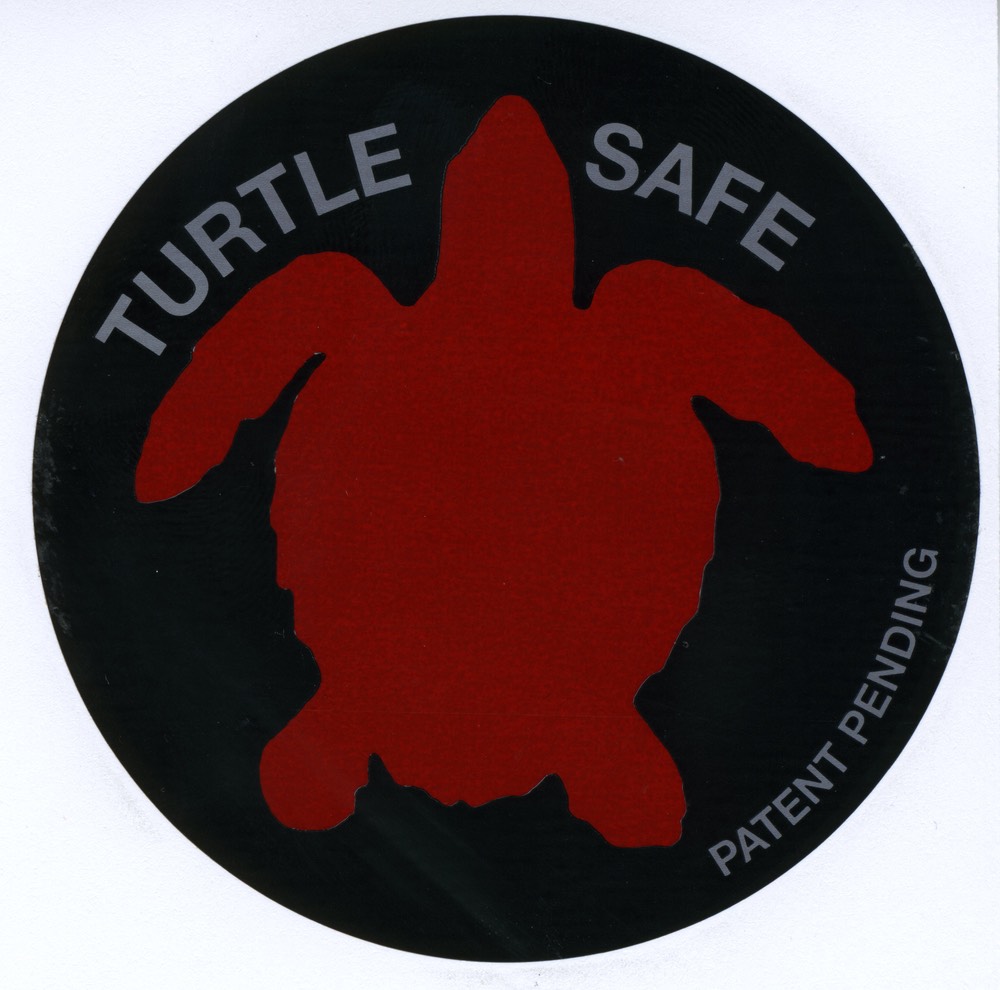
Flashlight sticker designed by Arix Zalace
Meanwhile, just as beams of artificial light deter the female from going ashore to nest, extraneous lights cause hatchlings to stray rather than scramble to the ocean. Witnessing hatchlings firsthand, Arix Zalace has seen babies wander toward seemingly negligible amounts of light. “I was with several turtle watchers when we saw hatchlings turn toward a cell phone in use,” he said.
Since the height of South Walton’s tourism season coincides with prime nesting and hatching season—the first of May through the end of October—Zalace sought a win-win solution to the lighting predicament. The son of ichthyologists, Zalace acquired his parents’ environmental interests. He was also born with a proclivity for science, especially physics, the basis of his invention.
“Nocturnal animals like sea turtles have night vision that enhances their ability to see shorter wavelengths,” explained Zalace. “Along the electromagnetic spectrum, the longest wavelengths are characterized by violets and blues, while reds and yellows emit the shortest wavelengths.” The relevant point is that animals with night vision are not distracted by reds that fall within a wavelength range of 560 to 680 nm. Zalace, therefore, focused on developing a flashlight shield that filtered light so that only reds within the undetected frequency shined through. “By using a protective shield on flashlights, tourists and residents could help safeguard the loggerheads’ nesting and hatching while they continued to enjoy the beach after dark,” offers Zalace.
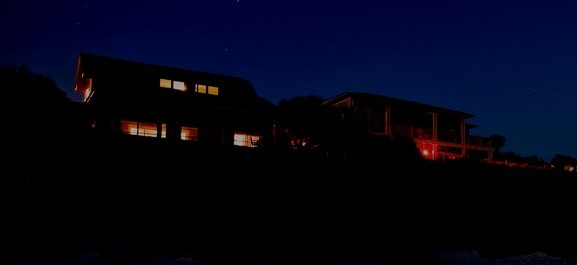
Bad Light (Left), and Good Light (Right)
“By using a protective shield on flashlights, tourists and residents could help safeguard the loggerheads’ nesting and hatching while they continued to enjoy the beach after dark.”
While a light filter was an obvious answer in Zalace’s eyes, the idea of creating a sticker that would adhere to any flashlight lens, yet easily peels off later was his lightbulb moment. His girlfriend, Jennifer Kuntz, owner of Raw & Juicy, the organic juice and snack bar on Central Square in Seaside, added the wow factor. “Jennifer said to me, ‘Why not make the sticker look like a sea turtle?’” Zalace, an artist, loved her suggestion and incorporated that image. “The red light in itself is rather cool,” said Zalace, “but projecting the silhouette of a loggerhead with your converted flashlight is even more fun. We had kids in mind, but adults are just as happy with the red turtle light.”
A former CFO for a toy company, Zalace worked through the production details. Quantities are now available in three standard sizes. Zalace also holds a provisional patent for other animal shapes. “The applications are endless because the filters apply to all nocturnal animals.” He cites migrating birds and wolves as examples. “You can purchase a sticker for pocket change, so why not take advantage of a simple yet vital way to protect wildlife?” His plans include making the filters available to state and national parks across the country.
Zalace is also marketing solar-paneled, aluminum flashlights in three sizes—penlight, five inches, and six inches—to generate revenue to support the cause. Each model will bear his exclusive loggerhead logo. “It takes fifty-five times more energy to manufacture a disposable battery than a solar flashlight, so I naturally had to go with the solar option,” said Zalace. “Besides, our flashlights have a life of eight to ten years.”
Other tie-in merchandise will include jewelry and art. Jewelry designer Heidi Viau of Lilly Pilly is creating a line of sea turtle pendants, earrings and pins. “Heidi uses a laser to carve intricate, one-of-a-kind beads that she makes from natural materials like shell and wood,” said Zalace, who is currently building an inventory of his own impressive paintings and sculpture for future shows.
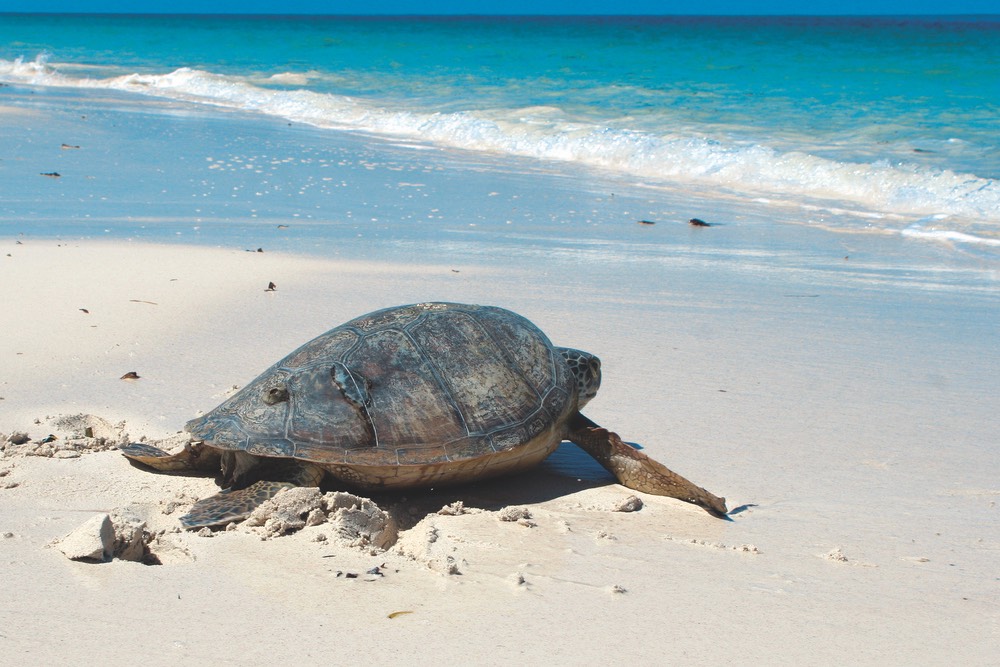
To spread the word among resort managers and business owners, who could either give away the filters as promotional items or sell them for a modest fee to locals and tourists, Zalace designed a display for the light filters to use in reception areas and retail stores. He also recruited friends and the musical duo Ma Muse to develop public service announcements for television. The commercials are co-sponsored by South Walton Community Council, a nonprofit organization committed to “preserving and protecting the quality of life and the environment.”
During the spring, Zalace took his message on the road, appearing at farmers’ markets, festivals, and Earth Day celebrations in cities along the Panhandle. “Our purpose was to build awareness beyond South Walton,” said Zalace. A broader effort is informing property owners of the need to keep lighting low to the ground as well as to minimize beach illumination with lamp shields. “Once people understand the reasoning behind our initiatives, most are overwhelmingly responsive.”
Even though Zalace admits that his conservationist endeavors are not always appreciated, he doesn’t mind being called a “tree hugger” as long as people understand his motives. “Yes, I love animals and trees, but I equally want to preserve the planet’s ecosystems for our own survival.”
So, what does a lumbering loggerhead bring to its ecosystem? “By munching on sea grass, sea turtles promote thicker, healthier root systems,” explained Zalace. “In turn, sea grass is home to fish and crustaceans. It’s a safe haven for minnows. When vegetation diminishes, so do fish populations.” Turtle eggs that don’t hatch are also a premium source of fertilizer for dune plant life. “The condition of sea turtles and the health of the ocean are intricately entwined; a thriving or diminishing sea turtle population indicates the state of the ocean.”
So, what would a healthy sea turtle population look like? Turtle watchers currently count approximately thirty nests each season along the nineteen miles of Walton Beach. In comparison, the seventy-two miles of Broward County beaches, with enforced lighting ordinances, are home to about 1,000 nests. Even with 1,000 nests, sea turtles are hardly overpopulating the area. The odds of a hatchling reaching adulthood are, at best, one in 1,000, and the actual ratio may be closer to one in 10,000. “If the natural elements are most favorable, then only one hatchling from every ten nests will live to adulthood,” said Zalace.
Though he also has plenty of responsibility as the owner of D&A Maintenance, Zalace is committed to positive change through education. “Being ‘in the know’ is about preservation of an endangered species as much as it is about ensuring the long-term wellbeing of humans.”
— V —
Casting A New Light On Sea Turtles from VIE Magazine on Vimeo.
Share This Story!
KEEP UP WITH THE LATEST STORIES FROM VIE
















































































































































